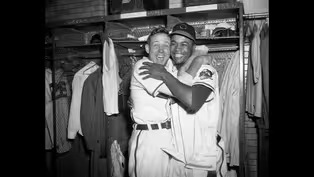
Detroit artist Jay Elias is helping lead a revival of metalworkers using iron for art
Clip: Season 9 Episode 40 | 9m 46sVideo has Closed Captions
One Detroit’s Bill Kubota talks with Detroit metalworking artist Jay Elias about using iron for art.
Making art out of metal – it can be a complicated process, and to make sculptures out of iron can be even tougher as the raw material needs to be heated up to 3,000 degrees. That process is being mastered by Detroit artist Jay Elias, who specializes in making art from iron. One Detroit’s Bill Kubota talks with Elias about the resurgence of iron as a medium and the complicated process to make it.
Problems playing video? | Closed Captioning Feedback
Problems playing video? | Closed Captioning Feedback
One Detroit is a local public television program presented by Detroit PBS

Detroit artist Jay Elias is helping lead a revival of metalworkers using iron for art
Clip: Season 9 Episode 40 | 9m 46sVideo has Closed Captions
Making art out of metal – it can be a complicated process, and to make sculptures out of iron can be even tougher as the raw material needs to be heated up to 3,000 degrees. That process is being mastered by Detroit artist Jay Elias, who specializes in making art from iron. One Detroit’s Bill Kubota talks with Elias about the resurgence of iron as a medium and the complicated process to make it.
Problems playing video? | Closed Captioning Feedback
How to Watch One Detroit
One Detroit is available to stream on pbs.org and the free PBS App, available on iPhone, Apple TV, Android TV, Android smartphones, Amazon Fire TV, Amazon Fire Tablet, Roku, Samsung Smart TV, and Vizio.
Providing Support for PBS.org
Learn Moreabout PBS online sponsorship(gentle music) - [Bill] Jay Elias's backyard in Detroit, the Near Eastside.
- [Jay] I'm a self-declared un-artist.
- [Bill] Elias started casting metal a little over a decade ago.
This day he's pouring bronze.
- [Jay] You know, it's such a subjective term.
It's because I feel like it's somewhat pretentious in a lot of ways, in a lot of circles.
(flame whooshing) - [Bill] There's a community around here that does this kind of thing.
- [Jay] You know, back, I guess the Bronze Age, right?
That's when man discovered how to manipulate metal.
It was used for like tools and weaponry and stuff.
But then, you know, like when you think of industry, you think of like iron and steel, right, which came later.
(metal clunking) - I think it is a little bit industrial.
It's like a microcosm of the Detroit ambiance.
This whole city was built on like different types of metal, and here we are in the backyard.
- This is as industrial of a process as the iron.
But you know, we do iron too, right?
There's lots of iron stuff here.
That's what I really prefer is the iron.
- [Bill] February, 2025, Cranbrook, Bloomfield Hills, the cradle of mid-century modern design.
An iron pour is about to happen facilitated by Jay Elias.
- It's like very humbling.
It's still kind of surreal almost.
Man, in 2017, I didn't know what the hell I was doing.
I never had run a furnace before.
And now here I am bringing a crew together to help these guys at Cranbrook - [Bill] Pouring iron for art's sake, an undertaking that doesn't happen too often.
The College for Creative Studies in Detroit does a couple of pours each year, but this will be the first for Cranbrook in many decades.
(gas booming) (observers cheering) It looks like the interest for iron is picking up.
- I think that's happening because we spend so much of our time with like screens on our phones, computers, where it's really exciting to be able to create something out of material that like you put labor and love into it, and then an object comes out.
- The legacy of iron pouring at Cranbrook is deeply connected to Julius Schmidt who was an artist in residence in the 1960s.
He built six furnaces that became a part of what was formerly the Cranbrook foundry which is now where the sculpture department is located.
- [Bill] Julius Schmidt, called the grandfather of cast iron sculpture, would spread his expertise to other art schools across the country.
He died in 2017.
- If, in order to pour iron, you're making the furnace and making the tools, making the torches, making everything, to then pour the molds that you, it's like so very from scratch, everything.
- Cast iron is so hard.
It's also super brittle.
So if you get it out of the mold, and you hammer too hard, you break it.
In that aspect, it's a very finicky material, and it has its own conditions.
- It's come back, you know.
Jay's bringing it back here, and that really means a lot to the community, that it was first started here, and now we're bringing it back.
- [Bill] Elias comes to this with a dark past revealed in his studio in Detroit.
Abused as a child, he says, a Marine Corps vet with post-traumatic stress, then 11 years in prison for aggravated assault!
- That was the impetus for everything, for Evolution Art Studio, was learning how to pour iron and really just expressing myself non-verbally through a lot of the stuff that I was making.
It was just a very cathartic process for me.
It was a pivotal moment in my mental shift to realize that I wasn't a victim.
That's when I realized I was a survivor.
- [Bill] What's on that paper?
What do you got going on?
- Just sketching out a project that I'm doing that's gonna be installed at the Carrie Furnaces in Pittsburgh, Pennsylvania.
The focus is gonna be a set of jail cell doors that I harvested from the old 3rd Precinct in Detroit, and I'm going to use them as the focal point of a large-scale sculpture.
(children chatting indistinctly) - [Bill] Pittsburgh, like Detroit, a shiny downtown and a legacy of iron: steel.
The Carrie Blast Furnaces date back to the 1880s, shut down 40 years ago.
Now a group called Rivers of Steel provides a backdrop for artists and iron pours like this one with Elias in the middle of it.
- So this entire region that's referred to as the Rust Belt did the innovation for the entire world.
Detroit, you know, you've got Chicago, you've got Pittsburgh, you've got Ohio cities, you've got Buffalo, New York, and I mean that's pretty much the people who wrote and built the modern era.
- [Bill] Elias oversees the furnace, firing up to 3,000 degrees.
(observer cheering) - I train for this.
I go to the shvitz like every day.
(laughs) So I'm in the sauna every day.
It helps me withstand the heat up there.
- [Bill] Hundreds of pieces to be cast including elements for Elias's project.
Where are these folks from?
- [Jay] All over the country, man.
Got people from different schools: Penn State University, Alfred University, Shepherd University, Wayne State University.
- [Bill] Wayne State?
That's Elias's school, graduating with a psychology degree this spring.
- [Jay] So that's coke right there.
That's super-heated coal, and they use that as fuel.
And then we throw those brake rotors in.
They get donated from the local scrap yard.
We just melt down the brake rotors.
- [Bill] All told, two and a half tons of brake rotors.
- So every one of those brake rotors was on a car or a truck or some sort of vehicle.
So, (steam hissing) when you think about all the stories that are attached to all those brake rotors.
They drove people to the hospital when their kids were sick.
They drove trucks to work every single day.
Those brake rotors are part of the reason why the system works the way it does, and they get discarded, you know.
It's kind of metaphorical to take stuff that's been discarded by society, and take it and then put a lot of pressure on it and transform it into art, right, something very visceral that really you could touch it, you could feel it, you could smell it.
The heat's there.
Like it's, this is a full-body experience.
- I kind of, people run towards it or run away from it because it's somewhat dangerous, but, to me, it's very zen.
I get very peaceful when I'm around it.
(mallet bashing) - [Jay] Some regular weld gloves that we're (indistinct) - [Metalworker] Going in.
(brush scraping) (hammer tapping) There'll be various smaller sculptures welded in place.
Oh man!
what do you think, Bill?
- [Bill] What do you think?
- It's sick.
It's beyond what I could have ever imagined in my head.
The steel doors are really heavy, and all the iron's really heavy, which lends itself to the weightiness of the story and the idea of incarceration.
(tractor revving) The nonprofit here at Rivers of Steel, they suggested, "Hey, we want you to install sculpture "in the Iron Garden," which kind of blew me away.
Like, next to Ken Payne and Vaughn Randall, like that, in itself to me, is like an honor 'cause I'm a relative newcomer to the cast iron game, you know.
(coal banging) - [Bill] Elias calls this work "Unfinished Business," now on display in the Iron Garden behind the Carrie Blast Furnaces.
- This piece, unlike some of the others, really draws you in, and you want to interact and read the text and not just walk by it.
- Celli, Marcelli, you gotta go in.
It could be interpreted as art.
I feel better if other people call me an artist than if I call myself an artist.
I do it more for myself, you know, to satisfy like some creative urge that I have inside of me that fortunately facilitates a healing process which is is why I embrace it so deeply.
It's not so much for the creation of the thing, but it's in the creation of the thing, the fellowship with my community, the learning that takes place, the growth that takes place, all the humility that takes place.
So this is kind of a way to just initiate dialogue, and a lot of people can relate to this story from all walks of life.
Iconic hug photo from 1948 World Series, a symbol against racism nearly 80 years later
Video has Closed Captions
Clip: S9 Ep40 | 11m 52s | It was a hug between two baseball players who helped the Cleveland Indians win the World Series in 1 (11m 52s)
One Detroit Weekend | Things to do around Detroit this weekend: April 4, 2025
Clip: S9 Ep40 | 2m 11s | One Detroit contributor Cecelia Sharpe shares upcoming events happening around metro Detroit. (2m 11s)
Providing Support for PBS.org
Learn Moreabout PBS online sponsorship
- News and Public Affairs

Top journalists deliver compelling original analysis of the hour's headlines.

- News and Public Affairs

FRONTLINE is investigative journalism that questions, explains and changes our world.












Support for PBS provided by:
One Detroit is a local public television program presented by Detroit PBS

